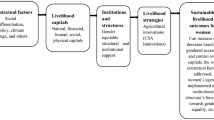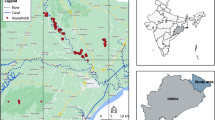Abstract
Crop raiding by the elephants is a serious and recurring management problem around protected areas in Kenya such as Meru National Park. Crop-raiding menace is one of the most significant of human–elephant conflicts in Meru National Park. The distribution, impact, and conservation implications of the increased elephant crop raiding in areas adjacent to Meru National Park is attributed to the changes in land use systems within these areas. Crop raiding by African elephants (Loxodonta africana) was monitored in the area adjacent to Meru National Park between August 2010 and July 2011. From the study, 144 farms were raided and farmers lost crops amounting to USD 120,308.60. Crop raiding was higher during the month of August 2010 (KES 2,714,295 or USD 33,928). The study suggests capacity building for communities in order to safeguard their crops against elephant raiding. Other probable measures put forward to mitigate this include the development of alternative water sources and the need to implement electric fence around the remaining section of the Park boundary which is affected by elephant.




Similar content being viewed by others
References
Barnes RFW, Asika S, Asamoah-Boateng B (1995) Timber, cocoa and crop-raiding elephants: a preliminary study from southern Ghana. Pachyderm 19:33–38
Barnes RFW, Craig GC, Dublin HT, Overton G, Simons W, Thouless CR (1999) African elephant database 1998. IUCN/SSC African Elephant Specialist Group, Gland, Switzerland
Bell RHV (1984) The man-animal interface: an assessment of crop damage and wildlife control. In: Conservation and Wildlife Management in Africa. Bell, R.H.V. & Mcshane-Caluzi (eds.), US Peace Corps Seminar, Malawi
Blanc JJ, Barnes RFW, Craig GC, Dublin HT et al. (2007) African Elephant Status Report 2007: An Update from the African Elephant Database. Occasional Paper of the IUCN Species Survival Commission, no. 33 IUCN/Species Survival Commission African Elephant Specialist Group IUCN, Gland, Switzerland
Caitlin EO, Rodwell T, Rice M, Hart AH (2000) Living with the modern conservation paradigm: can agricultural communities co-exist with elephants? A five- year case study in East Caprivi, Namibia. Bio Conserv 93:381–391
Campbell H, Gichohi A, Mwangi L et al (1999) Interactions between people and wildlife in SE Kajiado District. Kenya Ford Foundation, Nairobi
Hedges S, Tyson MJ, Sitompul AF et al (2005) Distribution, status and conservation needs of Asian elephants (Elephas maximus) in Lampung Province, Sumatra, Indonesia. Biol Conserv 124:35–48
Hillman Smith AKK, Merode ED, Nicholas A et al (1995) Factors affecting elephant distribution at Garamba National Park and surrounding reserves Zaire, with a focus on human–elephant conflict. Pachyderm 19:39–48
Hoare R (1992) Present and future use of fencing in the management of larger African mammals. Environ Conserv 19:161–164
Hoare RE (1999 a) Assessing the Evidence for the Existence of Habitual Problem Elephants Pages 1-2 IUCN African Elephant Specialist Group Report, Nairobi, Kenya
Hoare RE (1999 b) A standardized data collection and analysis protocol for human–elephant conflict situation in Africa IUCN African Elephant Specialist Group Report, Nairobi, Kenya
Hoare RE, Du Toit JT (1999) Coexistence between people and elephants in African Savannas. Conserv Biol 13:633–639
Kangwana K (1996) Assessing the impact of human elephant interactions studying elephants. African Wildlife Foundation, Nairobi
Kioko J, Okello M, Murithi P (2006) Elephant numbers and distribution in Tsavo Amboseli ecosystem, southwestern Kenya. Pachyderm 40:61–68
Kioko J, Murithi P, Omondi P, Chiyo PI (2008) The performance of electric fences as elephant barriers in Amboseli, Kenya. S Afr J Wildl Res 38:52–58
Litoroh M, Nicholas A, Masinde P (1994) A survey of the Marsabit National Reserve elephants and large mammal population. A KWS report, Nairobi, Kenya
Lusingi W (1981) New approaches to wildlife conservation in Kenya. Ambio 10(2–3):87–92
Monney KA, Dakwa KB, And Wiafe ED (2010) Asssessment of crop raiding situation by elephants (Loxodonta africana cyclotis) in farms around Kakuma conservation area, hana. Int J Biodivers Conserv 2(9):43–49
Naughton-Treves L (1997) Farming the forest edge: vulnerable places and people around Kibale National Park, Uganda. Geogr Rev 87:27–46
Ngene MS, Omondi P (2008) The costs of living with elephants in the areas adjacent to Marsabit National Park/Reserve Kenya. Pachyderm 45:77–87
Nyhus PJ, Tilson R, Sumianto M (2000) Crop raiding elephants and conservation implications at Way Kambas National Park, Sumatra, Indonesia. Oryx 34:262–274
Omondi P, King J, Bitok E, Geddes C (2002) Total aerial count of elephants and buffalo in the Tsavo/Mkomazi ecosystem. Nairobi: Kenya Wildlife Service/CITES-MIKE Programme
Osborn FV (2003) Seasonal influence of rainfall and crops on home-range expansion by bull elephants. Pachyderm 35:3–59
Parker GE, Osborne FV (2001) Dual-season crop damage by elephants in Eastern Zambezi Valley, Zimbabwe. Pachyderm 30:49–56
Sitati NW, Walpole MJ, Smith RJ et al (2003) Predicting spatial aspects of human–elephant conflict. J Appl Ecol 40(4):667–677
Sitati NW, Walpole MJ, Leader-Williams N (2005) Factors affecting susceptibility of farms to crop raiding by elephants: using a predictive model to mitigate conflict. J Appl Ecol 42:1175–1182
Smith RJ, Kasiki SM (1999) A spatial analysis of human–elephant conflict in the Tsavo Ecosystem IUCN African Elephant Specialist Group Report
Sukumar R (1989) The Asian elephants: ecology and management. Cambridge University Press, Cambridge
Sukumar R (1991) The management of large mammals in relation to male strategies, and conflict with people. Biol Conserv 55:93–102
Tchamba MN (1995) The problem elephants of Kaele: a challenge for elephant conservation in northern Cameroon. Pachyderm 19:26–31
Woodroffe R, Thirgood S, Rabinowitz A (2005) People and wildlife: conflict or coexistence? Cambridge University Press, Cambridge
Zint M, Kraemer A, Northway H, Lim M (2002) Evaluation of the Chesapeake Bay Foundation’s conservation education programs. Conserv Biol 16(3):641–649
Author information
Authors and Affiliations
Corresponding author
Additional information
Communicated by C. Gortázar
Rights and permissions
About this article
Cite this article
Sitienei, A.J., Jiwen, G. & Ngene, S.M. Assessing the cost of living with elephants (Loxodonta africana) in areas adjacent to Meru National Park, Kenya. Eur J Wildl Res 60, 323–330 (2014). https://doi.org/10.1007/s10344-013-0789-5
Received:
Revised:
Accepted:
Published:
Issue Date:
DOI: https://doi.org/10.1007/s10344-013-0789-5




